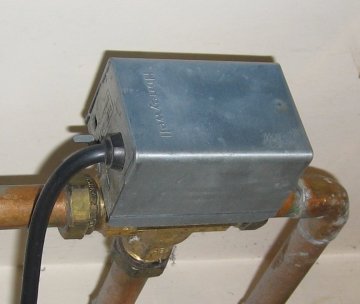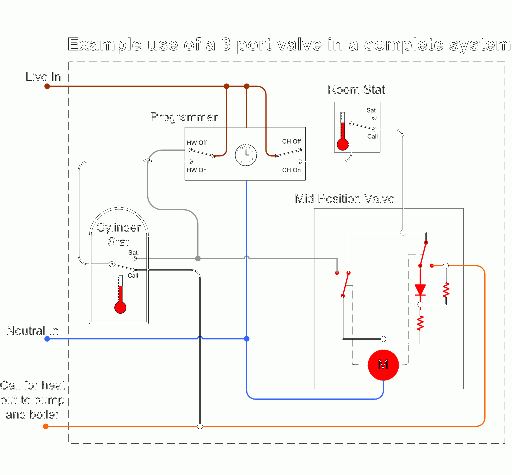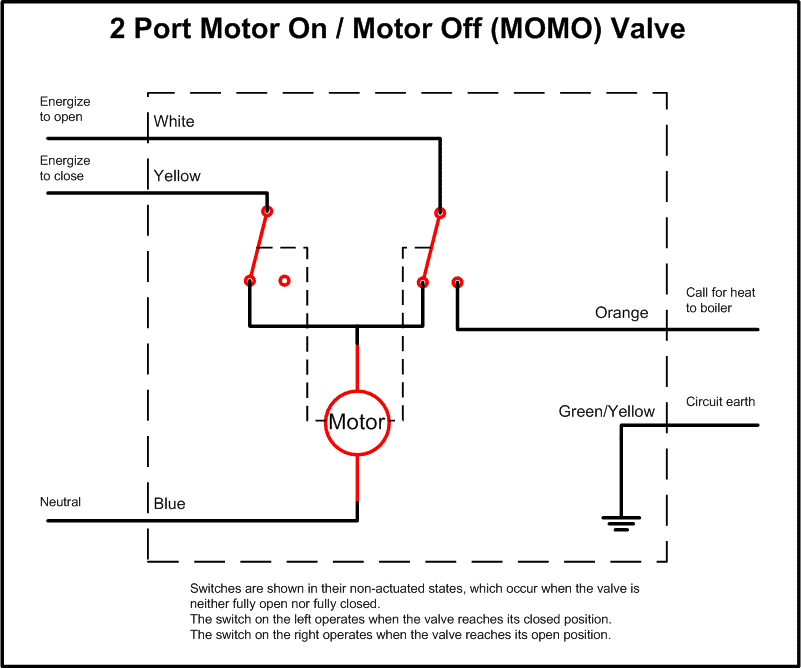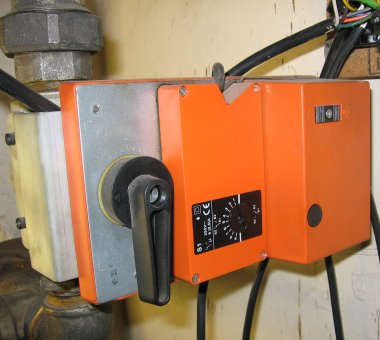Motorised Valves
This article is about motorised valves used in Central Heating systems. Motorised valves are a type of electrically actuated valve (others include solenoid valves and valves using electrically-generated thermal effects).
Motorised valves generally comprise:
- a synchronous electric motor
- gears to reduce the speed and increase the torque output of the motor
The motor and gears are often combined in a package known as a Synchron motor.
- a linkage from the output gear to the hydronic part of the valve
- one or more switches (usually microswitches) actuated by, for example, a cam attached to the output linkage
- a spring: see below
- the above components usually comprise one module, often known as the 'head', which may be detatched from the parts below for repair or replacement.
- a valve controlling flow of water in the hydronic system, actuated by the head: this part is often known as the 'body'.
Configurations of motorised valve
Valves are commonly found in the following configurations:
2-port
The valve has 2 pipe connections (ports) and permits or blocks flow between the ports depending on whether it is actuated or not. Flow is permitted when the valve is actuated and blocked in its resting state.
When the valve is energised a synchronous motor drives the vale to the open position untill the motor stalls and stays in that position. When the valve is required to close then power is removed and a spring return drives the mechanism ( and the motor) backwards to its original closed rest position.
3-port
The valve has 3 pipe connections, in a T formation. The centre leg of the T is the inlet and the two short arms are the outlets, usually referred to as ports A and B. Actuation controls whether the flow from the inlet passes to the A or B port. In the resting state flow is to the B port (usually the hot water circuit).
There are two types of 3-port valve:
- Diverter valve
: This is a simple change-over version of a 2-port valve: when the valve is actuated all flow is diverted to the B outlet.
Alt desc
In this version the 3 port valve is required only to divert flow from port A to B or vice versa. The is no mid position
- Mid-position valve
- In this type of valve there is a stable state in which flow from the inlet can pass to both (A and B) outlet ports simultaneously. This type of valve is commonly found in domestic central heating systems where it controls flow of hot water from a boiler to hot water and radiator circuits in a Y-plan system configuration.
Types of motorised valve
Spring return valves
In these types when power is applied the motor and gears act against the force of a spring to operate the valve. When power is removed the spring returns the valve to its resting position. In a 2-port valve this is the closed position. In a 3-port valve the resting position is where flow from the inlet passes to the B port (DHW).
These types of valve consume power whenever they are open (and, in the case of 3-port valves, often even when they are not). In 2-port valves the motor runs until the valve is fully open and then stalls as the actuator mechanism cannot move any further. 3-port valves are more complicated: a description can be found in the uk.d-i-y FAQ. An example of how a 3-port valve integrates into a system:
For detailed wiring diagrams of Y Plan and other zoning systems see the main CH Zoning article.
Motor On / Motor Off (MOMO) valves
In these types of valve the motor is used to drive the motor from one position to the next. Switches in the mechanism stop the motor when it has reached its desired position.
Since the motor only runs whilst the valve is changing from one state to another there is a saving in energy compared to valves where the motor runs continuously while the vale is open. Such valves may also be more reliable since the motor and surrounding components will run cooler.
2-port
This type of valve changes from it closed (off) to its open (on) position when power is applied to one terminal, and from open to closed when power is applied to another terminal.
These types of valves are occasionally found in domestic central heating systems: usually as Satchwell or Sunvic valves with grey plastic heads. Sunvic manufacture both MOMO and spring-return valves in similar casings.
If a motor-open/motor-close valve is replaced by a spring-return valve, or vice-versa, the controls wiring must be modified to suit. In the case of replacing a spring-return with a MOMO valve this requires change-over contacts at the room thermostat (or progstat) and an extra wiring conductor between the 'stat and the valve.
| This type of valve is also found in non-domestic installations. |
3-port
Sunvic's SDMV series 3-port valves are motor-open/motor-close types but are wired identically to spring-return valves. Since they only consume power when moving from one position to another (A to mid-position, mid-position to B, B to mid-position and mid-position to A) they save electrical power compared to spring-return 3-port valves. Compared to the Honeywell-type 3-port valve's 2 microswitches, one diode and 2 resistors the Sunvic valves contain more electronics: two relays and 3 micro-switches. Additionally they use two circuits each comprising a mains-voltage capacitor, bridge rectifier, electrolytic capacitor and diode to drive the relays which are 24V DC coil types, rather than using relays with mains-voltage coils: presumably the latter would be larger and/or more expensive than components of these circuits. However despite the (still relatively modest) amount of electronics in the Sunvic valves they may be expected to be more reliable than the spring return valves since:
- the motor does not have to overcome the pull of the spring when moving towards the B position, and uses the motor rather than a spring to return all the way back to the A position, so a motor of given power can deal with greater friction in the mechanical components of the valve before failing to operate it properly
- the valve head runs cooler as it is not dissipating heat from the electrical current passing for hours on end, which should reduce heat-related failure of components
Switchmaster
Switchmaster valves with bright blue plastic heads are found in some older domestic installations.
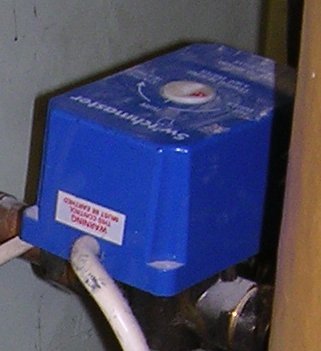
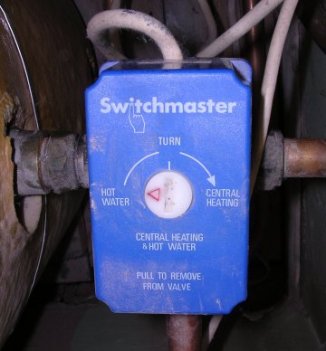
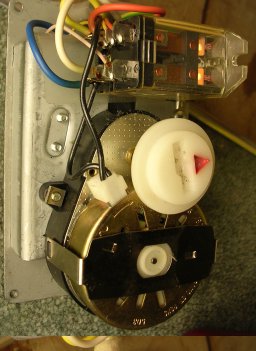
- A thread on uk.d-i-y suggests that these are NOT wired as for spring-return - cf Y Plan schematic diagram above).
| red | sw live to boiler & pump |
| orange | HW on (from cylinder 'stat) |
| white | HW off (from cylinder stat) |
| yellow | CH on (from room 'stat) |
| blue | neutral |
| green/yellow | earth |
- Another thread discusses wiring and plumbing changes required to replace this type of valve.
